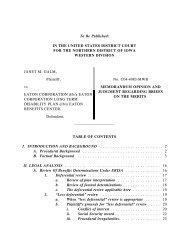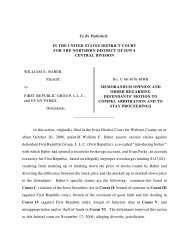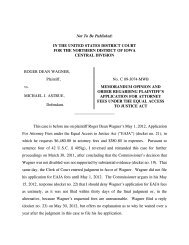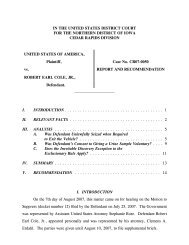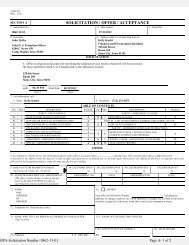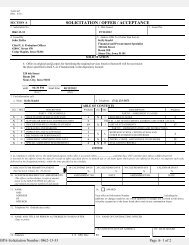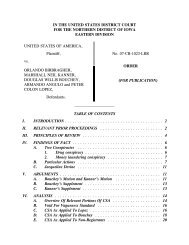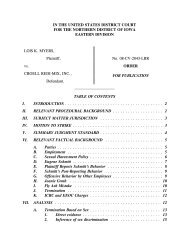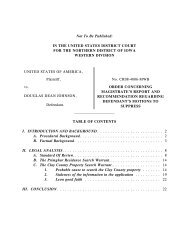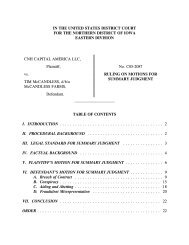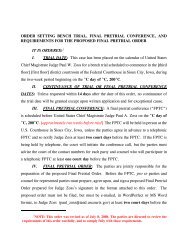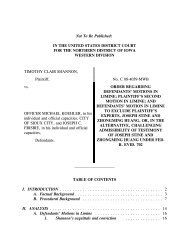Arnzen v. Palmer - Northern District of Iowa
Arnzen v. Palmer - Northern District of Iowa
Arnzen v. Palmer - Northern District of Iowa
Create successful ePaper yourself
Turn your PDF publications into a flip-book with our unique Google optimized e-Paper software.
ordering the defendants to point the cameras at the ceiling or, alternatively, to cover the<br />
camera lenses with lens caps. The defendants resist the motion, arguing that the cameras<br />
serve an important institutional purpose because they provide a method for monitoring the<br />
activities <strong>of</strong> patients in bathrooms, where there is “a high likelihood <strong>of</strong> patients acting out<br />
physically and/or sexually.” Doc. No. 20-2, p. 1. The defendants also allege that<br />
procedures have been implemented to govern the use <strong>of</strong> the cameras that protect the<br />
privacy interests <strong>of</strong> the plaintiffs.<br />
Legal Standard<br />
Discussion<br />
“A preliminary injunction is an extraordinary remedy never awarded as <strong>of</strong> right.”<br />
Winter v. Natural Res. Def. Council, Inc., 555 U.S. 7, 24 (2008) (citing Munaf v. Geren,<br />
553 U.S. 674, 689-90 (2008)).<br />
In each case, courts “must balance the competing claims <strong>of</strong> injury and must<br />
consider the effect on each party <strong>of</strong> the granting or withholding <strong>of</strong> the<br />
requested relief.” Amoco Production Co.[v. Gambell], 480 U.S. [531,] 542,<br />
107 S. Ct. 1396, 94 L.Ed.2d 542 [(1987)]. “In exercising their sound<br />
discretion, courts <strong>of</strong> equity should pay particular regard for the public<br />
consequences in employing the extraordinary remedy <strong>of</strong> injunction.”<br />
[Weinberger v.] Romero–Barcelo, 456 U.S. [305,] 312, 102 S. Ct. 1798,<br />
1803 [(1982)]; see also Railroad Comm’n <strong>of</strong> Tex. v. Pullman Co., 312 U.S.<br />
496, 500, 61 S. Ct. 643, 85 L.Ed. 971 (1941).<br />
Id. The Eighth Circuit Court <strong>of</strong> Appeals has since explained:<br />
When evaluating whether to issue a preliminary injunction, a district<br />
court should consider four factors: (1) the threat <strong>of</strong> irreparable harm to the<br />
movant; (2) the state <strong>of</strong> the balance between this harm and the injury that<br />
granting the injunction will inflict on other parties; (3) the probability that<br />
the movant will succeed on the merits; and (4) the public interest.<br />
Dataphase Sys., Inc. v. C L Sys., Inc., 640 F.2d 109, 114 (8th Cir. 1981)<br />
2



